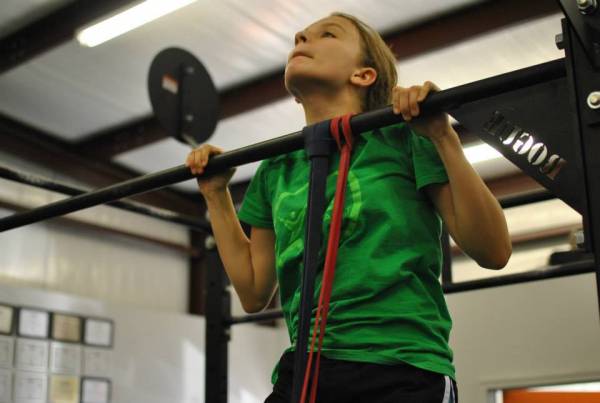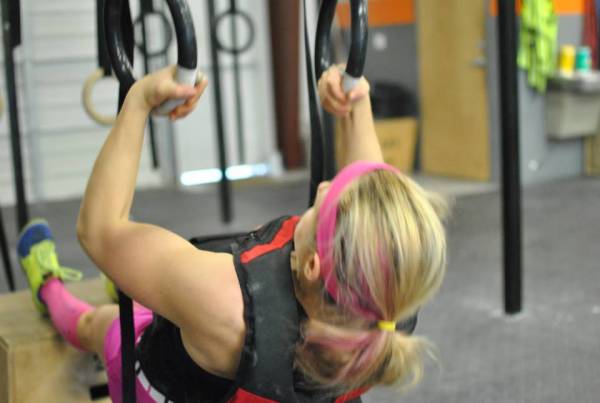When engaged in serious training in the gym, it is best to operate under a set of well-informed principles. These principles may vary depending on the circumstances, but it is in your best interest to have a clear understanding of the what, why, and how behind your chosen exercise. Your movement standards, for instance, can dictate a lot about the efficacy of your training.
With this in mind, I invite you to reconsider the use of elastic bands for pulling movements such as pull ups or chin ups. Instead, I would like to discuss the use of these bands for pushing movements such as push ups, dips, and headstand pushups.
The Impact of the Strength Curve
Anyone who has ever tried a push up or pull up intuitively knows there is a strength curve inherent to each exercise. In both of these movements, your muscles contract concentrically and eccentrically in order to move your joints through flexion and extension. It is precisely at the point when your joints are in flexion where the most challenging portion of the range of motion typically occurs.
Which can you hold longer, the top of a pull up or the bottom? The bottom of a push up or the top? Push ups start at the top of the movement with your arms are extended, and then begin an eccentric contraction down towards the floor, reaching the bottom of the movement when your arms are flexed. The most challenging portion of the range of motion in a push up is typically the bottom.
On the other hand, pull ups start at the bottom of the movement with your arms extended, and then begin a concentric contraction up toward the bar. When you reach the top of a pull up, your arms are fully flexed. This means the most challenging portion of the range of motion for pull ups is the top, and not the bottom like with the push-up.
(EDIT: Rather than say pull ups are “easiest” at the bottom, it would be more accurate for me to say pull ups are most challenging both at the very bottom and at the very top of the range of motion. Thus, a more nuanced perspective would be that using elastic bands for assistance on pull ups is appropriate IF the athlete struggles most with the bottom of the movement, but can otherwise reach the top position without assistance.)
What Is Accommodating Resistance?
At this point I encourage you to do some research on accommodating resistance. Look up Louie Simmons and Westside Barbell, and do a training cycle of four to six weeks where you experiment with chains and bands for your squats and deadlifts.
You will notice an immediate change in the feeling of the movement, precisely because using accommodating resistance for squats and deadlifts increases the load at the strongest point of the lift and decreases the load at the weakest point. Similar to push ups and pull ups, the weakest point in your lifts is when the joints are in flexion (coming out of the bottom of your squat and lifting the bar off the floor in a deadlift) and the strongest point is when the joints are extended (when you stand up with the weight).
Applying These Principles to Bodyweight Exercises
With this deeper understanding of why you might want to use elastic bands in the gym, let us now discuss how to apply the principle of accommodating resistance (or really, accommodating assistance) to bodyweight exercises.

As stated, in pulling movements like chin ups or pull ups, the strength curve is such that the movement is easiest at the bottom and most difficult at the top. If an athlete cannot complete a full-range-of-motion pull up, whether due to weakness or fatigue, standard operating procedure in many gyms (particularly CrossFit gyms) is to give the person a band in order to finish the workout. By allowing an athlete to use a band for pull ups, he or she will usually be able to complete the full movement and build confidence and experience in the movement pattern.
However, there are a few significant drawbacks. The band, due to its elastic nature, will provide the most assistance when stretched the most, which in the case of a pull up is actually the bottom of the movement. (Reminder: pull-ups are easiest at the bottom!) When you get to the top and need the most help, the band is stretched the least and thus provides the least help.
As a result, athletes often cheat the top range-of-motion of banded chin ups and pull ups, or they end up using a band thick enough to help them at the top, but so thick that it does not adequately challenge their strength at the bottom. Truth be told, I shed a tear every time I witness a thick band, short range-of-motion pull up or chin up.
Please, ditch the bands for pull up work. Prioritize horizontal rows, isometric holds, and slow negatives. If an athlete does not have the requisite strength to perform a clean, crisp, full range-of-motion chin up, then do not ask him or her to do chin ups.

There Is a Better Way
Now, do not fret, as you can still find a good use for those overpriced elastic bands that you bought online. In fact, they work well for pushing movements such as push ups, dips, and headstand push ups.
In these pushing movements, the strength curve is such that the movement is easiest at the top and most difficult at the bottom. Voila! This means when you anchor an elastic band above your body, it will be stretched the most at the bottom and will provide the most assistance when you need it the most. Furthermore, at the top of the movement, when it is easiest to perform, the band will be stretched the least, thus providing the least assistance.
Now the bands are starting to look a lot better! For pushing movements, the bands match the strength curve. They also allow for gradual, incremental progression, and they, too, build confidence and experience in the movement pattern.
Suggestions for Using Elastic Bands in the Gym
Here are a few suggestions for using bands for pushing movements:
- When anchoring the band above your body, be aware that the precise height of the anchor point greatly matters. If you use a thinner band at a higher anchor point, it might actually end up providing the same amount of assistance as a thicker band just at a lower anchor point. Thus, I recommend you always use the exact same level for each movement.
- In order to progress towards thinner (and eventually no) bands, I recommend accumulating volume on the thicker bands. An athlete should be able to perform 5 sets of 5 reps with a given band before attempting the movement with less assistance. Coach Sommer of Gymnastic Bodies has his athletes start with 3 sets of 1 rep and progress up to 5 sets of 5 reps over the course of 12 weeks, for instance.
- There are many paths on this journey we call fitness, and many of them lead towards the same destination. Using bands can certainly work for some people for pull ups, but in my experience that path takes a bit longer and is fraught with poor movement quality. I recommend using elastic bands as an assistance aid only for movements where the sticking point is at the bottom (pistols, anyone?).
In closing, I would like to give credit and thanks to Carl Paoli, Christopher Sommer, Jim Bathurst, Ido Portal, and many other trainers and coaches out there for inspiring the ideas behind this article. Please feel free to reach out with any questions or comments. If you have other movements you are struggling with, please let me know about those, as well.
Photos courtesy of CrossFit Impulse.






